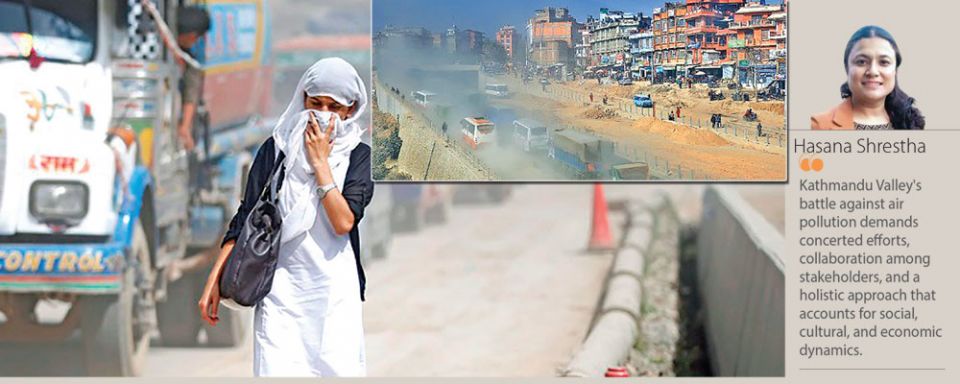
In recent times, the Kathmandu Valley has been under the spotlight due to persistently high Air Quality Index (AQI) readings, sparking widespread discussions about air pollution across mass media and social platforms. The AQI serves as a vital tool developed by government agencies to communicate the adverse effects of polluted air on public health. According to the State of Global Air, air pollution stands as the fourth leading cause of death worldwide, diminishing life expectancy by 2–2.8 years, almost equivalent to the perils of tobacco use.
The media often sheds light on air pollution, particularly when Kathmandu Valley finds itself shrouded in it. This phenomenon is hardly surprising, given the valley's dense population and its geography, which acts as a basin, trapping pollutants and suffocating its 1.5 million inhabitants. The sources of pollution within this urban expanse are diverse, ranging from heavy traffic on congested roads to open waste burning, industrial emissions (notably from brick kilns), and dust from ongoing construction activities. Over the past two decades, the government has rolled out various strategies to combat air pollution, such as banning two-stroke engines, restricting public vehicles over 20 years old, and transitioning brick kiln technology to more efficient alternatives like forced-draught and zigzag-firing technology. Additionally, imposing time limits for high-emission vehicles to enter certain areas has been a significant intervention. A pivotal initiative in this regard is the regulation of the Air Quality Management Action Plan for Kathmandu Valley (KVAQMAP) 2020, aimed at mitigating air pollution. However, despite these efforts, research indicates a concerning upward trend in pollution levels, particularly evident during dry months, casting a shadow of doubt on the efficacy of existing initiatives.
Seasonal variations in air pollution exhibit a recurring U-shaped trend annually within Kathmandu Valley. Pollution levels peak during March and April, gradually declining from June to October, only to surge again in November, reaching their peak in December and January. While monsoon rains aid in scavenging pollutants during June to October, other seasons witness pollution levels surpassing Nepal's national ambient air quality standards (NAAQS). Cross-border influences further exacerbate pollution levels in the valley, with pollution from neighbouring regions significantly impacting Kathmandu's air quality. Notably, at times the pollution reaches very unhealthy to hazardous levels as episodes due to sources that originate outside the valley, notably during March/April and October/November. April/May marks the peak of the forest fire season, typically commencing in November. According to servirglobal.net, the Department of Forests and Soil Conservation (DoFSC) reported 2,294 forest fires as of June 16th, 2023. Similarly, during November, farmers prepare fields for new crops, often burning leftover plant debris from rice harvesting, known as paddy stubble burning. Annually, the Punjab region in India witnesses the burning of approximately 7 to 8 million metric tonnes of leftover plant debris from rice farms during October and November, leading to significant air pollution across the Indo-Gangetic Plains.
The current unhealthy air pollution levels stem from forest fires in various regions of Nepal. From April 1 to April 26, the government portal for the Forest Fire Detection and Monitoring System in Nepal detected 2,852 fire events, predominantly in the southern belt. Understanding how southern forest fires impact pollution in Kathmandu necessitates recognising that air knows no boundaries. Particularly southwesterly and northwesterly winds prevail during the fire season, transporting pollutants from the southern border to Kathmandu. Air quality data from the Air Quality Monitoring Station at Ratnapark revealed a monthly average of PM2.5 exceeding 70 µg/m3 during April, surpassing the NAAQS of 40 µg/m3. It is pertinent to note that WHO Air Quality Guidelines recommend a diurnal average PM2.5 of 15 µg/m3.
Addressing air pollution in Nepal requires a multifaceted approach that considers cultural practices, behavioural patterns, and socioeconomic factors. For instance, TSI BlueSky air quality low-cost monitors installed by the Central Department of Environmental Science (CDES), Tribhuvan University, in collaboration with Duke University, highlighted alarmingly high pollution levels in the Eastern Terai, particularly during late evenings, attributing them to the open burning of firewood for warmth. This underscores the urgent need for alternative heating solutions, particularly during the winter months, to mitigate the harmful effects of air pollution on public health. Additionally, stubble burning, a cultural practice among farmers exacerbated by modern harvesting technologies, worsens air quality and necessitates comprehensive measures to address its root causes. To pinpoint pollution sources accurately, comprehensive measurements are imperative. While the Department of Environment (DoE) has deployed reference-grade monitors in 27 locations across Nepal, augmenting monitoring capabilities, particularly through the integration of low-cost sensors, offers a promising avenue for creating dense monitoring networks. Such networks would enhance our ability to accurately track air quality, identify pollution hotspots, and implement targeted mitigation measures.
As mentioned by the Lancet Commission on Pollution and Health, it is imperative to enhance monitoring capabilities, identify hyper-local sources of pollution, and integrate pollution prevention into national and city planning processes to effectively combat air pollution. While KVAQMAP 2020 serves as the guiding document for air quality management in Kathmandu Valley, it exhibits certain shortcomings that warrant revision and reassessment. These include the absence of specific pollution reduction targets, unclear timelines for actions, and the need for coordinated efforts among multiple government bodies. Moreover, the action plan falls short of addressing air quality levels exceeding unhealthy levels and remains silent on preventative measures to avert air quality from becoming a disaster (AQI > 300). Resolving cross-border pollution issues and empowering the Department of Environment (DoE) to monitor and forecast air quality nationwide emerge as pressing imperatives.
In essence, Kathmandu Valley's battle against air pollution demands concerted efforts, collaboration among stakeholders, and a holistic approach that accounts for social, cultural, and economic dynamics. Only through proactive measures and robust interventions can Kathmandu Valley pave the way towards cleaner, healthier air for its residents.
(Shrestha is an environment inspector at the Department of Environment.)












